Nokia Solutions and Networks CPE25750 WiMax CPE B2 Blade 2.5GHz User Manual 2
Nokia Solutions and Networks WiMax CPE B2 Blade 2.5GHz 2
Contents
- 1. User manual 1
- 2. User manual 2
User manual 2
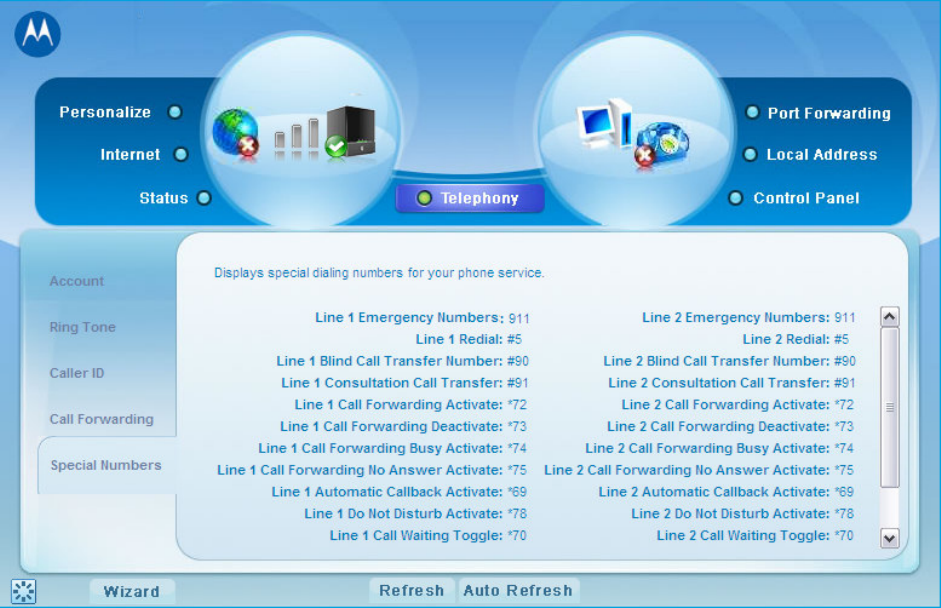
30
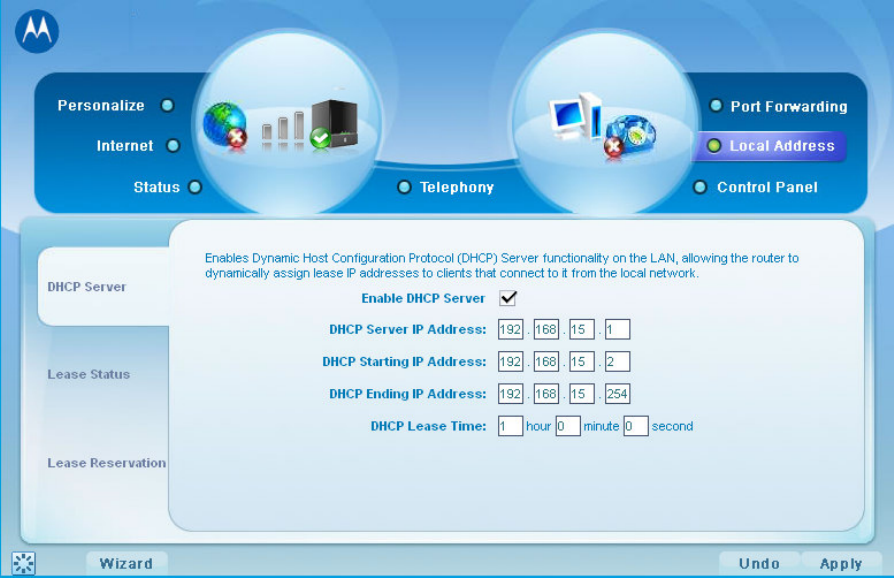
31
8. LAN (Local Address) Configuration
If DHCP is enabled on all of the computers in your home network (LAN), you
should not need to change any of the default LAN settings.
Unless you have sufficient networking knowledge, we recommend not changing
any LAN settings.
If you need to verify LAN Configuration, you can access this information by
performing the following:
1 Click the DHCP Server tab on the Home page.
2 Select the one you want to configure from the four: DHCP Server, Lease Status and
Lease Reservation.
D
DH
HC
CP
P
S
Se
er
rv
ve
er
r
This configuration enables Dynamic Host Configuration Protocol (DHCP) server
functionality on the LAN, allowing the router to dynamically assign lease IP
addresses to clients that connect to it from the local network.
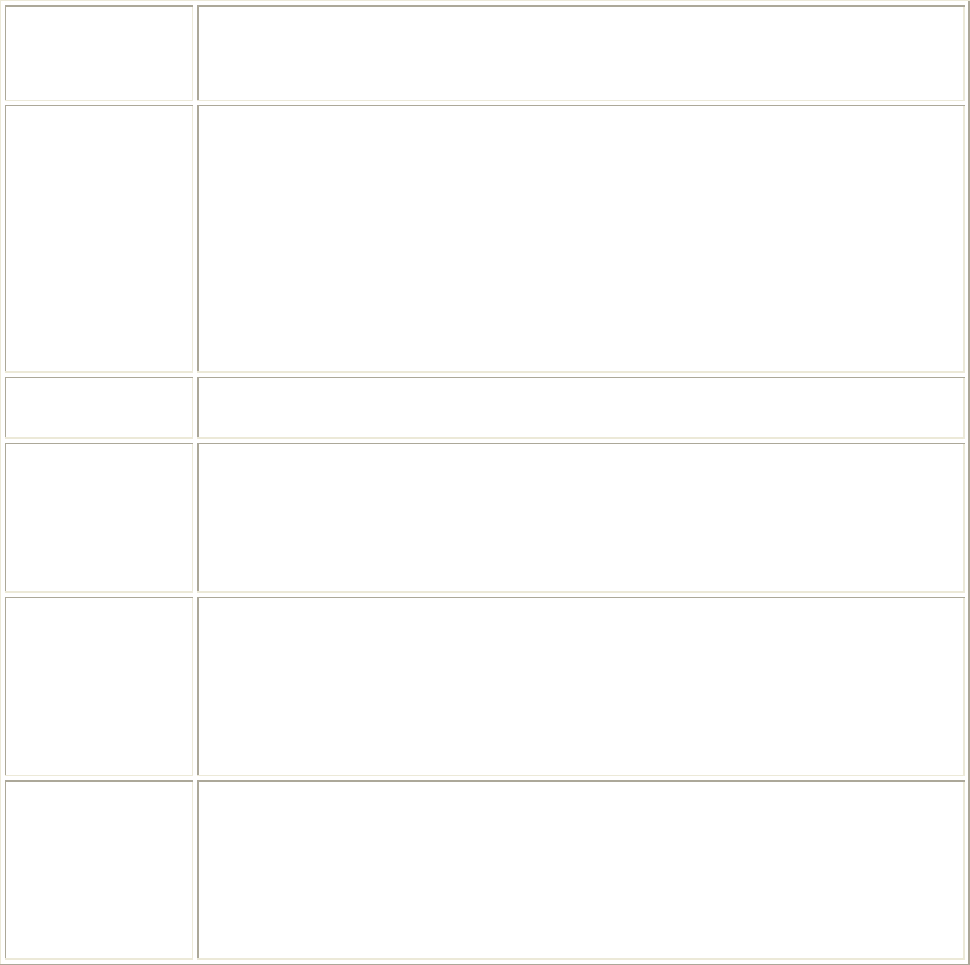
32
F
Fi
ie
el
ld
d
o
or
r
B
Bu
ut
tt
to
on
n
D
De
es
sc
cr
ri
ip
pt
ti
io
on
n
Enable DHCP
Server
If selected, the DHCP server on the gateway assigns IP addresses
to the computers and other hosts on your network, if they have
DHCP enabled. By default, the gateway DHCP server is enabled.
If there is another DHCP server running on your network (on
another router), you must disable one of the DHCP servers.
If you do not select, you must carefully configure the IP address,
Subnet Mask, and DNS settings of every host on your network. Do
not assign the same IP address to more than one host. Your
gateway must be on the same subnet as the other hosts.
DHCP Server IP
Address
Sets your DHCP Server IP address in dotted-decimal format. We
recommend not changing the default 192.168.15.1
DHCP Starting
IP Address
Sets the first IP address assigned by the DHCP server, in
dotted-decimal format. It must be greater than the IP address
value of the gateway. For example, if the IP address of the
gateway is 192.168.15.1 (default), the starting IP address must be
192.168.15.2 (or higher).
DHCP Ending IP
Address
Sets the final IP address assigned by the DHCP server, in
dotted-decimal format. It cannot exceed the subnet limit of 254.
For example, the default is 192.168.15.254. If the DHCP server runs
out of DHCP addresses, users cannot access network resources. If
this happens, increase the End IP (to the limit of 254) or reduce
the Lease Time.
DHCP Lease
Time
Sets the time, in seconds, that a network computer remains
connected to the gateway using its current assigned IP address.
At the end of this time, the DHCP server renews the lease or
assigns the computer a new IP address. The default is 3600
seconds (1 hour). The maximum is 999999 seconds (about 278
hours).
L
Le
ea
as
se
e
S
St
ta
at
tu
us
s
This section shows the active DHCP lease since the last reboot. For each active
lease, the client host name, MAC address, IP address and remaining lease
dureation are shown.
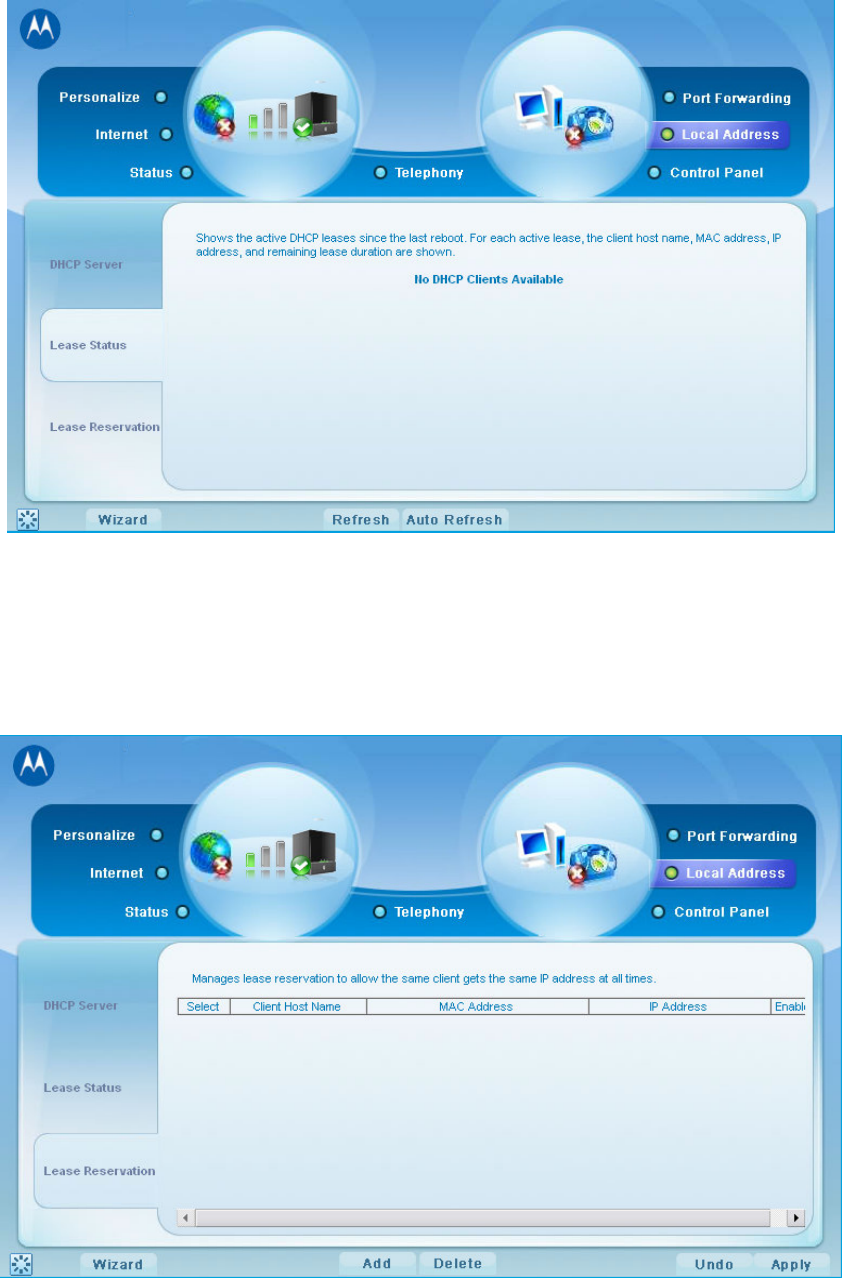
33
L
Le
ea
as
se
e
R
Re
es
se
er
rv
va
at
ti
io
on
n
It manages lesae reservation to allow the same client gets the same IP address at
all time. Give the client a Host Name, register its MAC address and reserve a set
of fixed IP address for this client. Click Apply to save the setting and this client will
be assigned the reserved IP address next time.
34
9. Port Forwarding
This section contains two parts: Basic and Forwarding. Port forwarding is the
forwarding of network ports from one network device to another. This is
commonly done using a NAT (network address translation) enabled router or
server and another computer within the network.
B
Ba
as
si
ic
c
The UPnP Internet Gateway Device (IGD) is an “edge” interconnect device
between a residential Local Area Network (LAN) and the Wide Area Network
(WAN). It provides connectivity to the Internet with automatic and seamless
sharing and configuration of Internet data access among networked devices in
the residential network.
UPnP functionality also provides user with:
1 Multi-player games
2 Real time communications (such as MSN Messenger)
3 Peer-to-peer services
You have to enable Universal Plug and Play (UPnP) Internet Gateway Device
(IGD) profile to allow certain Windows applications set up the port forwarding rule
dynamically when NAT is enabled on this device.
Enable a specific LAN client allows you to accept inbound connections which do
not match with any forwarding rules and triggering rules. This client sometimes is
referred as DMZ (Demillitarized Zone).
Follow the steps below to set up the UPnP.
1. From the Basic web page, click Add LAN Client. The DMZ cannot be enabled
until the LAN client is added.
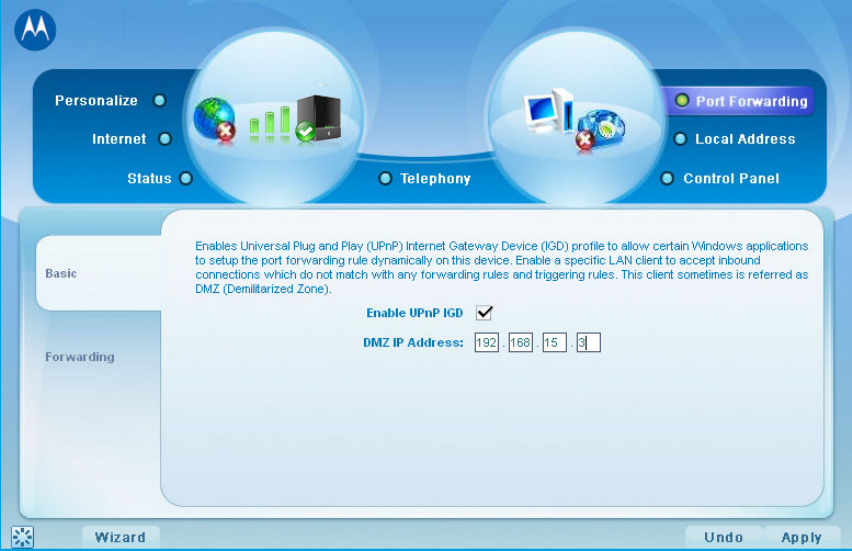
35
2. Click Apply to save the setting.
F
Fo
or
rw
wa
ar
rd
di
in
ng
g
This function is to forward inbound connections destined to ports on the BLADE
WiMAX interface, to a specific client on your local network. You can specify a
corresponding destination LAN port ranges as well. Port forwards can be used to
support a web server, or other special service, offered on your local network.
Followthe steps below to configure the Forwarding.
1. Fill in the Service name and selecthe protocol type. There are three protocol
types: TCP, UDP, TCP/UDP. Select the one that best suits your requirement.
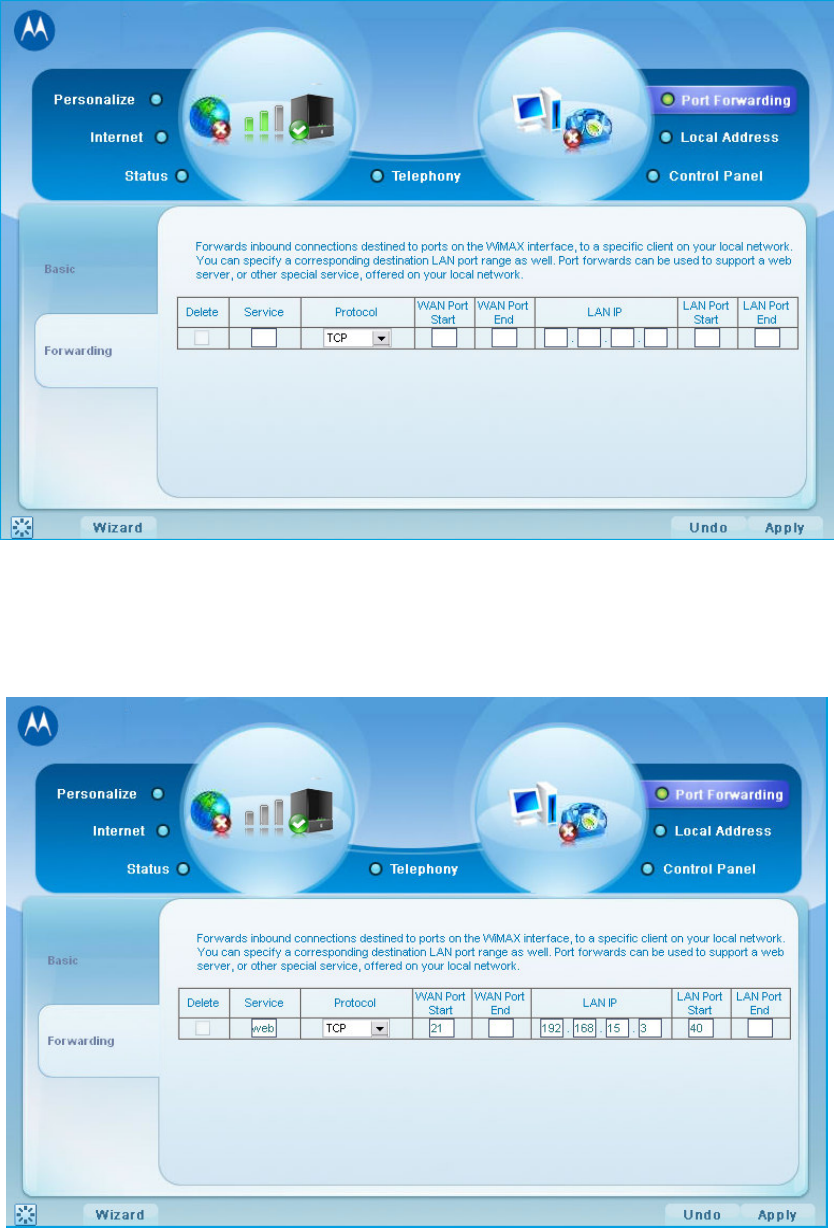
36
2. Continue fill in the rest boxes. The WAN Port Start and WAN Port End refer to the
range of the BLADE WAN port. LAN IP refers to the local PC’s IP address. The
LAN Port Start and LAN Port End refer to the range of the BLADE LAN port, and
they are registered for the WAN PCs to recognize.
3. Click Apply to save the setting.
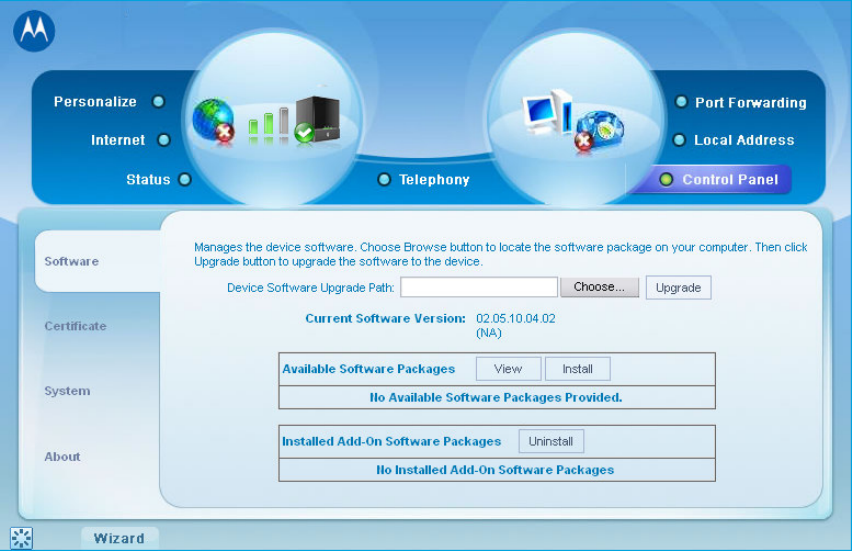
37
10. Control Panel
Control panel has three sections: Software, Certificate, and URL Filter. It manages
the firmware upgrade and device software, verifues the certificate for network
connection, and enables the URL filter.
Software
You can upgrade the firmware by clicking the Choose button and find the one
you want to upgrade, then click Upgrade. The Current Software Version shows
the software that is being run on your BLADE. The block below the current
software version is for you to install new softwares available from external servers.
Click View to find the available ones and click Install to make use of them. If you
find the installed software not necessary, simply click Uninstall on the bottom box
to remove them.
C
Ce
er
rt
ti
if
fi
ic
ca
at
te
e
This page manages the certificates stored on this BLADE. Click Choose button to
locate the certificate file in your computer and click Import button to add it the
the device. If you want to remove an existing certificate, click Delete to remove it.
If you check the Enable CRL Retrieval button, the BLADE will connect
automatically to external server and verify if the certificate is valid. It is
recommended to leave it as default value.
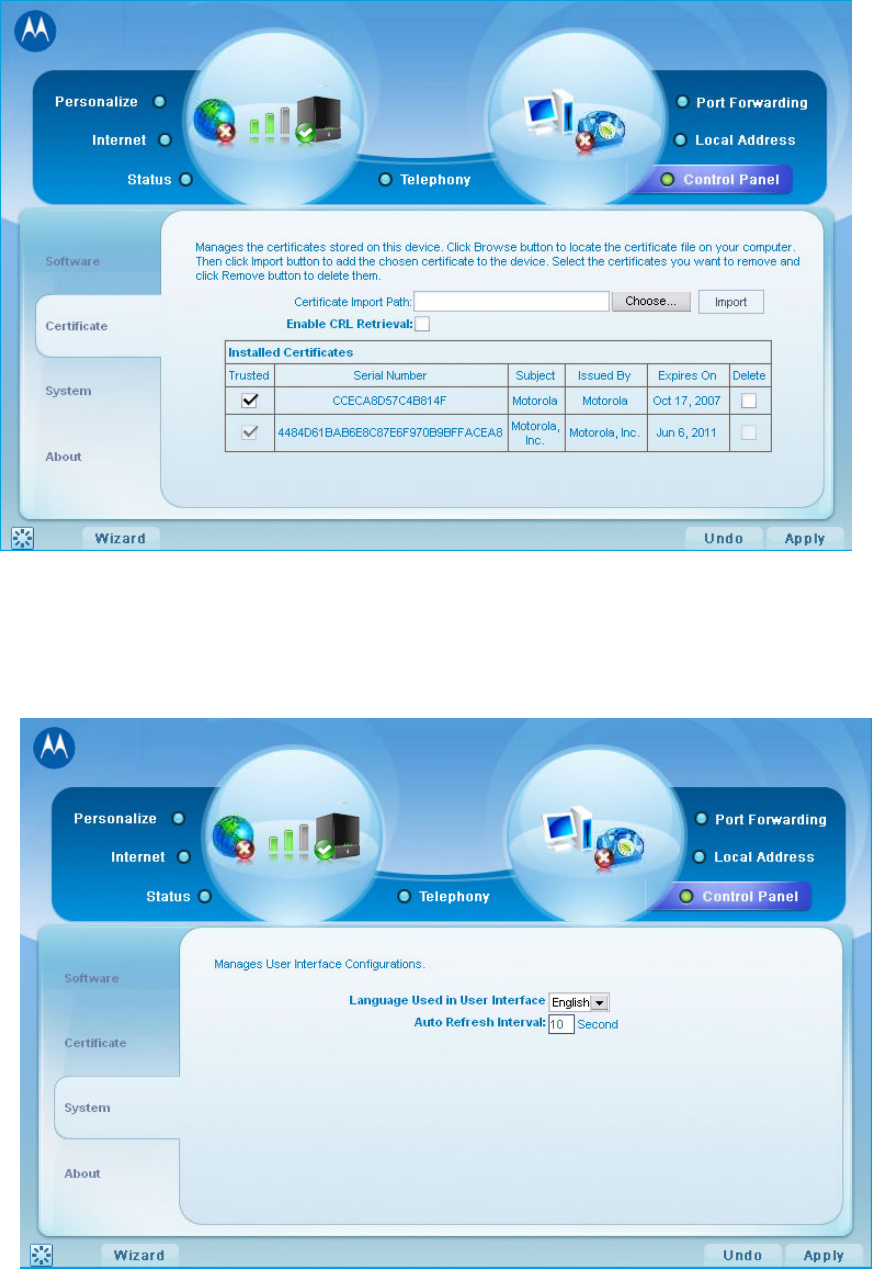
38
S
Sy
ys
st
te
em
m
This page controls the user interface configuration. You may change the
language used in user interface and the auto refresh interval as shown below.
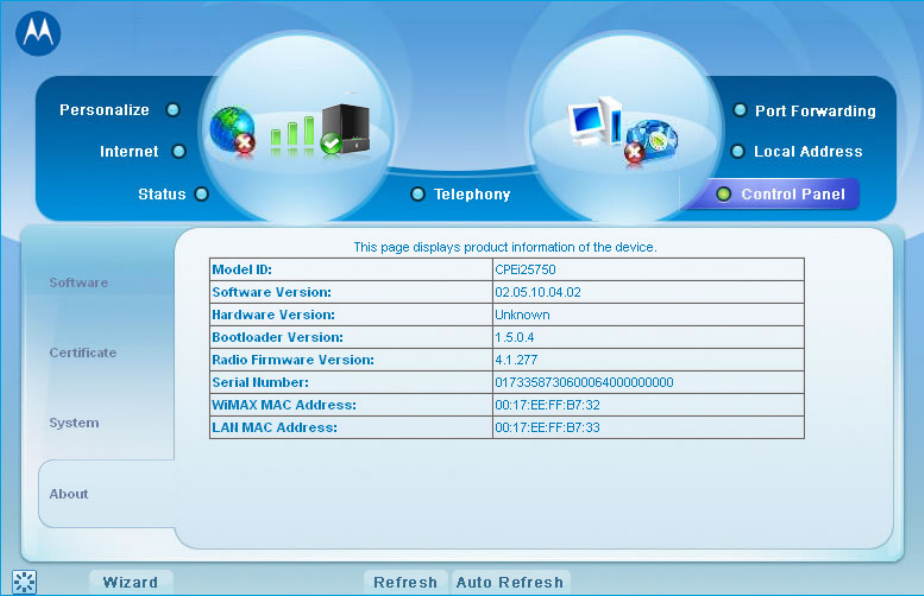
39
A
Ab
bo
ou
ut
t
As you can see from the sample web page below, this button shows basic
product information of the RSU. You may find model ID, software/hardware
version, etc.
40
11.Troubleshooting
L
LE
ED
Ds
s
a
ar
re
e
O
Of
ff
f
Check that the AC power adapter is properly plugged into the electrical
outlet and into the Gateway.
Check that the electrical outlet is working.
A
A
C
Co
om
mp
pu
ut
te
er
r
C
Ca
an
nn
no
ot
t
S
Se
en
nd
d
o
or
r
R
Re
ec
ce
ei
iv
ve
e
D
Da
at
ta
a
Check that the Ethernet cable is properly connected to the Gateway unit and
the computer.
C
Ca
an
nn
no
ot
t
C
Co
on
nn
ne
ec
ct
t
t
to
o
t
th
he
e
I
In
nt
te
er
rn
ne
et
t
If you cannot connect to the Internet for more than 5 minutes:
A: re-run the Setup Wizard
B: if the Setup Wizard does not help, then reset the Gateway using the Apply
button. For unit reset instructions see Top Panel.
C: contact your service provider if you still cannot connect to the internet after
performing the previous tasks.
41
12.Configuring TCP/IP
This chapter is needed for setup procedures. Refer to the section titled
“Basic Configuration” on Chapter 3 for more information regarding this
chapter.
All client computers on your network must be configured for TCP/IP (the
protocol that controls communication among computers). Perform one of:
Configuring TCP/IP in Windows XP
Configuring TCP/IP in Windows Vista
Follow the instructions in your Macintosh or UNIX user manual
After configuring TCP/IP, on all computers, perform one of the following to
verify its IP address:
Verifying the IP Address in Windows XP
Verifying the IP Address in Windows Vista
Note: For operating systems other than Windows:
Follow the instructions in your Macintosh or UNIX user manual
C
C
Co
o
on
n
nf
f
fi
i
ig
g
gu
u
ur
r
ri
i
in
n
ng
g
g
T
T
TC
C
CP
P
P/
/
/I
I
IP
P
P
i
i
in
n
n
W
W
Wi
i
in
n
nd
d
do
o
ow
w
ws
s
s
X
X
XP
P
P
1. On the Windows desktop, click Start to display the Start window:
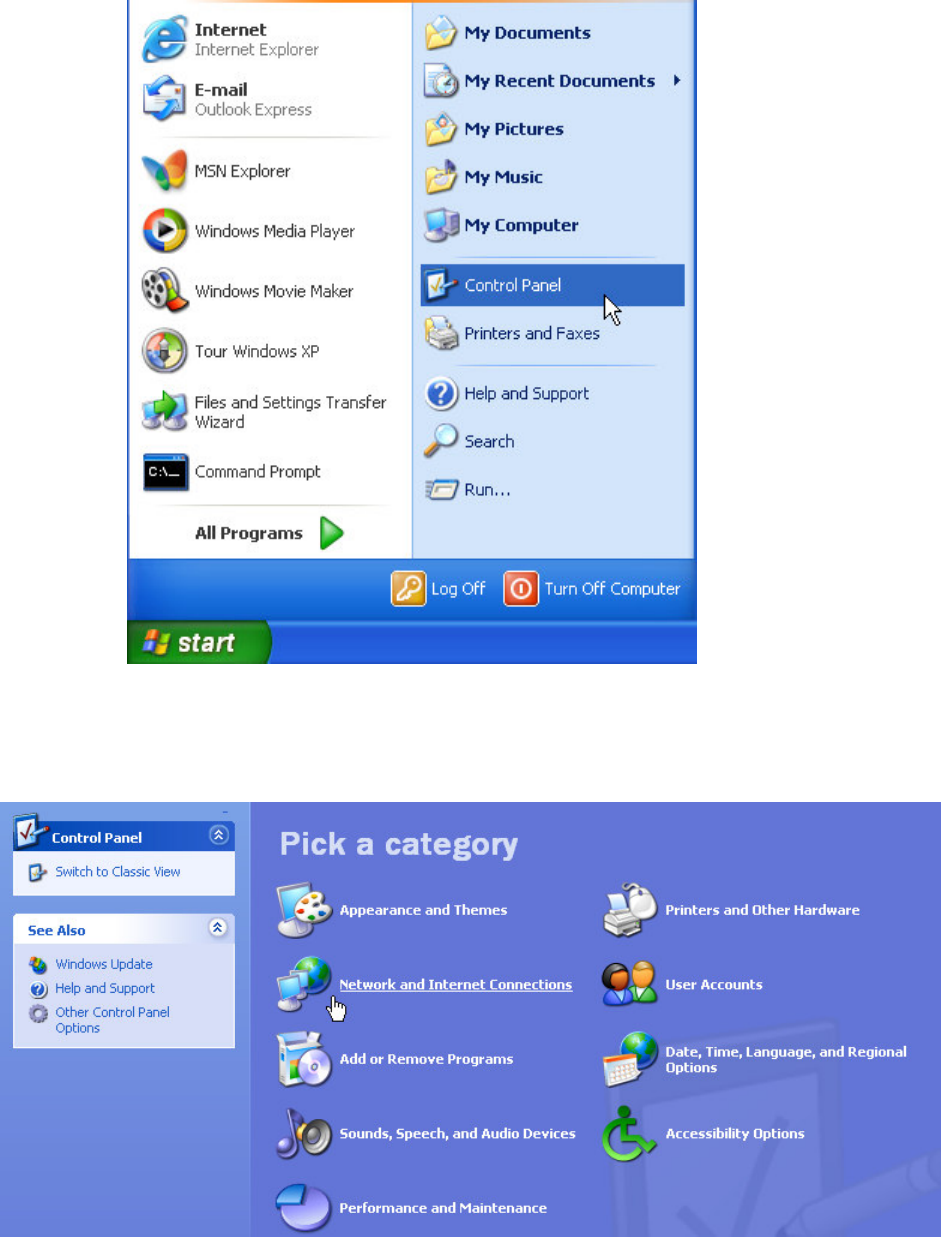
42
2. Click Control Panel to display the Control Panel window. The display varies,
depending on your Windows XP view options. If the display is a Category view
as shown below, continue with Step 3. Otherwise, skip to Step 5.
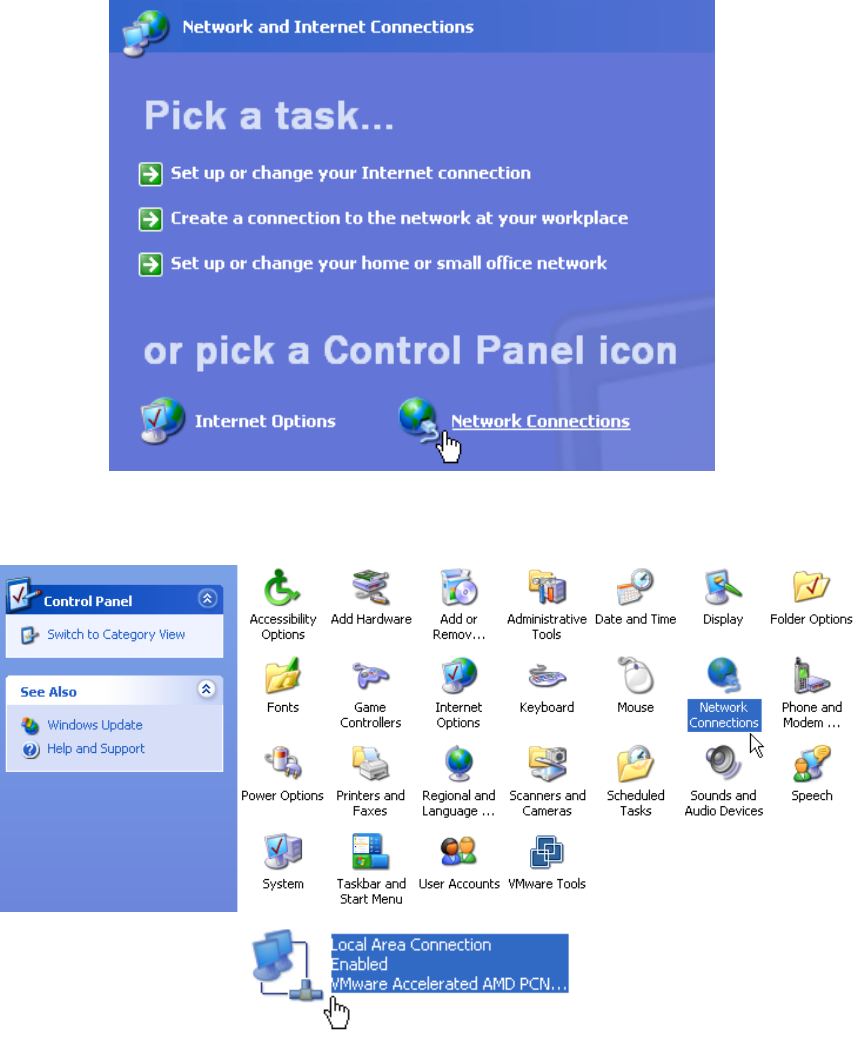
43
3 Click Network and Internet Connections to display the Network and Internet
Connections window:
4 Click Network Connections.
5 If a classic view similar to below is displayed, double-click Network
Connections to display the LAN or High-speed Internet connections.
6 Right-click the Local Area Connection. If more than one connection is
displayed, be sure to select the one for your network interface.
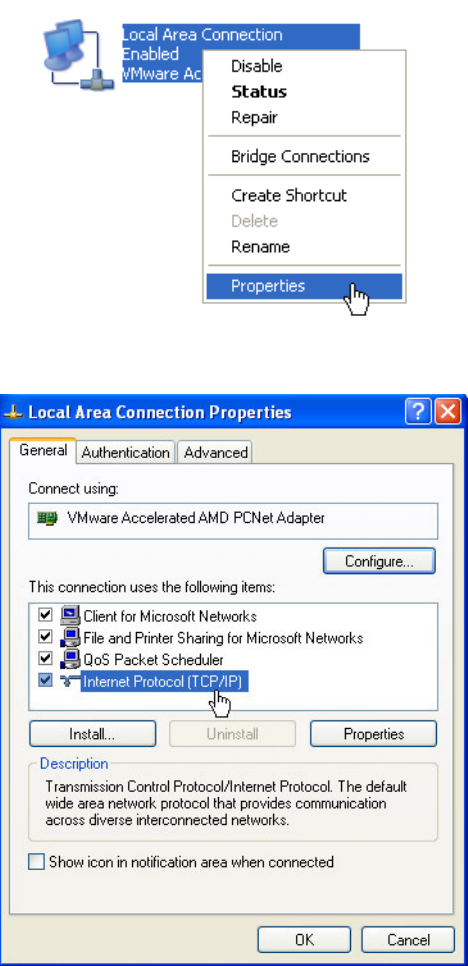
44
7 Select Properties from the pop-up menu to display the Local Area.
8 On the Local Area Connection Properties window, select Internet Protocol
(TCP/IP) if it is not selected.
9 Click Properties to display the Internet Protocol (TCP/IP) Properties window:
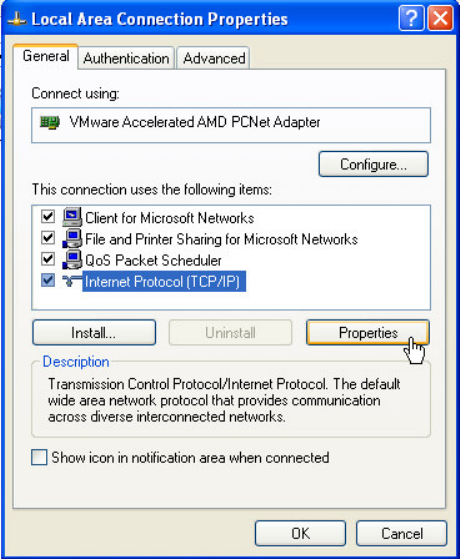
45
10 Be sure Obtain IP address automatically and Obtain DNS server address
automatically are selected.
11 Click OK to close the TCP/IP Properties window.
Click OK to close the TCP/IP Properties window. When you complete the
TCP/IP configuration, return to the Setup procedure “User Interface
Overview” on Chapter 3.
C
C
Co
o
on
n
nf
f
fi
i
ig
g
gu
u
ur
r
ri
i
in
n
ng
g
g
T
T
TC
C
CP
P
P/
/
/I
I
IP
P
P
i
i
in
n
n
W
W
Wi
i
in
n
nd
d
do
o
ow
w
ws
s
s
V
V
Vi
i
is
s
st
t
ta
a
a
1. On the Windows desktop, click Windows Logo on the left bottom cornor
to display the Start window. Then click Network.
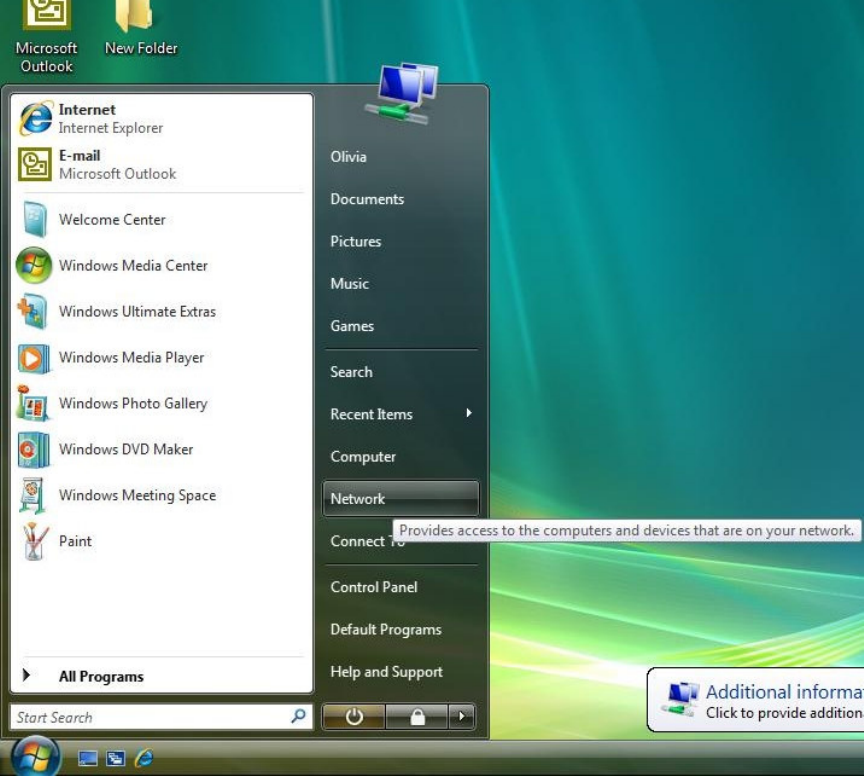
46
2. When Network windows appears, click Network and Sharing Center from
the action bar on the top of the window.
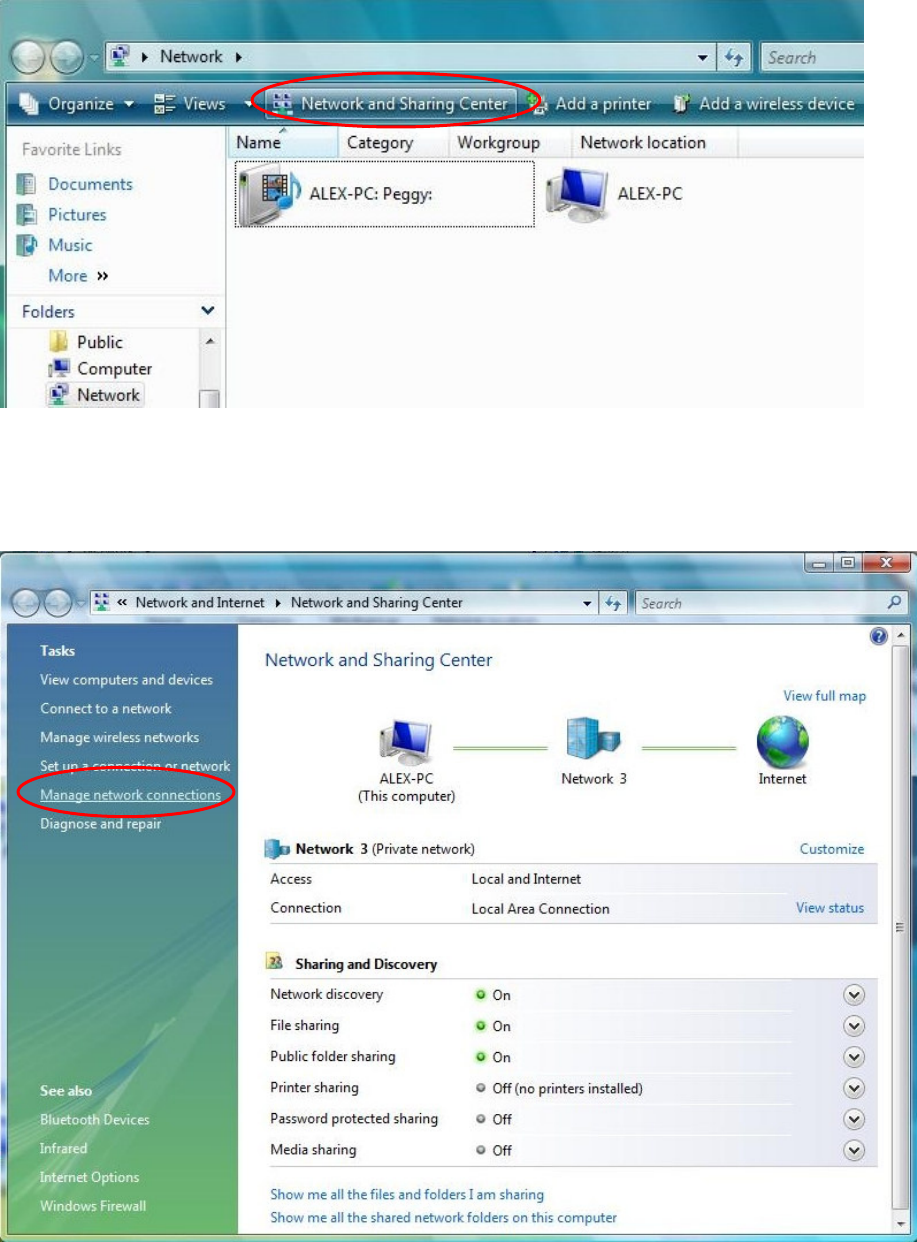
47
3 .After you click Network and Sharing Center, the window below
appears. Follow by clicking Manage Network Connection from the task
bar on the left.
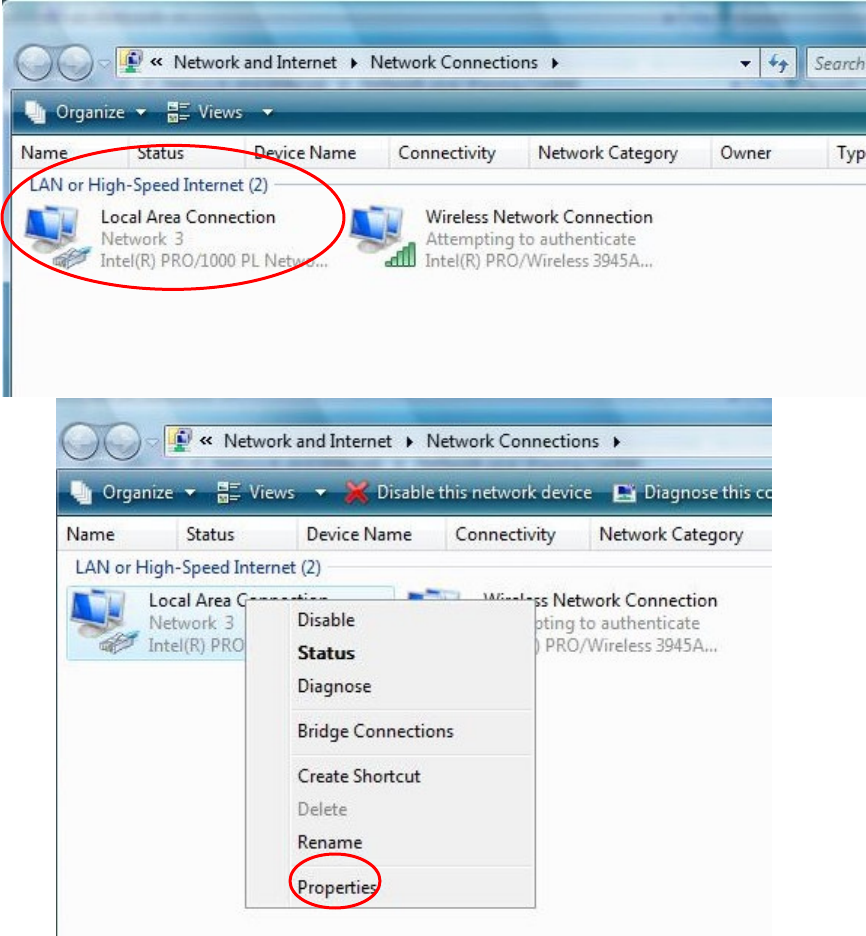
48
4. The network connections appear. Drag your mouse to the Local Area
Connection and right click the mouse button. A series of tasks display.
Click Properties.
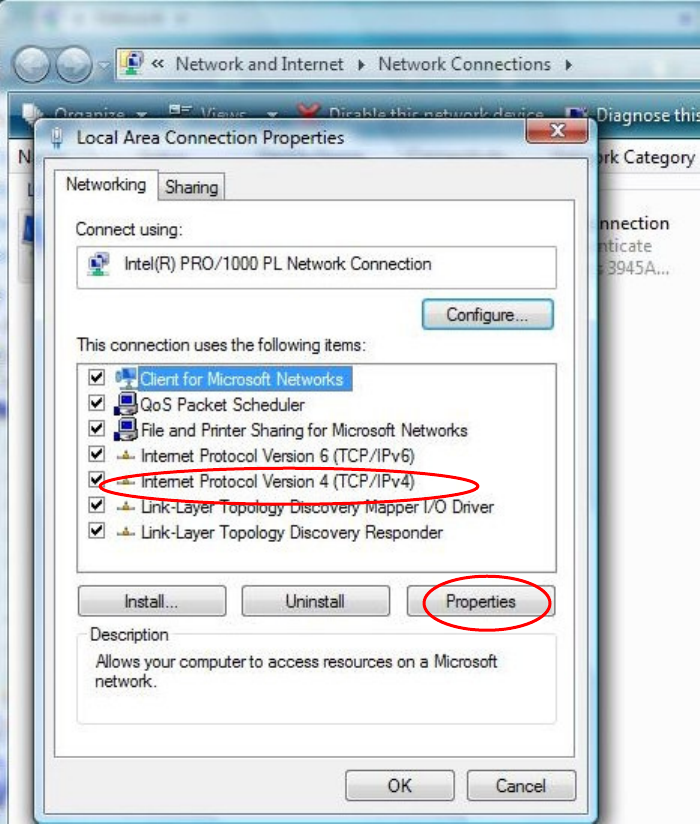
49
5. A series of protocols appear. Among them, check the Internet Protocol
Version 4 (TCP/IPv4) and click Properties.
6. TCP/IPv4 Properties appears. Check Obtain an IP address automatically,
and Obtain DNS server address automatically. Click OK to save the
settings.
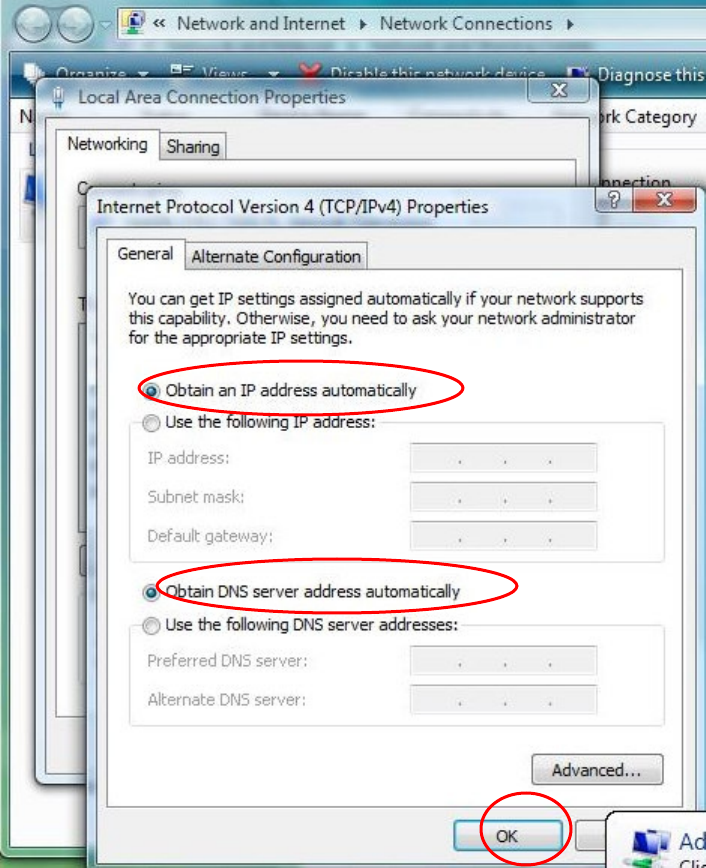
50
7. The settings are done. Click OK to exit.
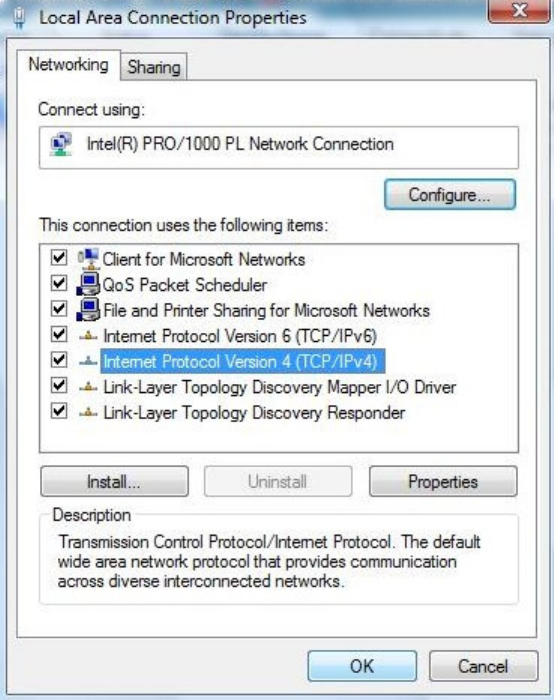
51
52
13.Important Safety and Legal Information
Your Motorola WiMAX Wireless Broadband BLADE is designed and tested to
comply with a number of national and international standards and
guidelines (listed below) regarding human exposure to RF electromagnetic
energy.
T
Th
hi
is
s
P
Pr
ro
od
du
uc
ct
t
c
co
om
mp
pl
li
ie
es
s
w
wi
it
th
h
t
th
he
e
f
fo
ol
ll
lo
ow
wi
in
ng
g
R
RF
F
e
en
ne
er
rg
gy
y
e
ex
xp
po
os
su
ur
re
e
s
st
ta
an
nd
da
ar
rd
ds
s
a
an
nd
d
g
gu
ui
id
de
el
li
in
ne
es
s:
:
United States Federal Communications Commission, Code of Federal
Regulations; 47CFR part 2 sub-part J
American National Standards Institute (ANSI)/ Institute of Electrical and
Electronic Engineers (IEEE) C95 1-2005
Institute of Electrical and Electronic Engineers (IEEE) C95.1-1999 Edition
International Commission on Non-Ionizing Radiation Protection (ICNIRP)
1998
Ministry of Health (Canada) Safety Code 6. Limits of Human Exposure to
Radiofrequency electromagnetic Fields in the Frequency Range from 3 kHz
to 300 GHz, 1999
Australian Communications Authority Radiocommunications
(Electromagnetic Radiation – Human Exposure) Standard, 2003
ANATEL ANNEX to Resolution No. 303 of July 2, 2002 “Regulation of
Limitation of Exposure to Electrical, Magnetic, and Electromagnetic Fields
in the Radio Frequency Range Between 9 kHz and 300 GHz” and
“Attachment to Resolution #303 from July 2, 2002”
R
RF
F
E
Ex
xp
po
os
su
ur
re
e
C
Co
om
mp
pl
li
ia
an
nc
ce
e
a
an
nd
d
G
Gu
ui
id
de
el
li
in
ne
es
s
O
Op
pe
er
ra
at
ti
in
ng
g
I
In
ns
st
tr
ru
uc
ct
ti
io
on
ns
s
To comply with FCC RF energy exposure requirements, this Gateway
desktop transmitter should be operated at a minimum separation distance
of 20 cm from all persons.
For additional information on exposure requirements or other training
information, visit http://www. motorola.com/rfhealth.
53
F
FC
CC
C
R
Re
eg
gu
ul
la
at
to
or
ry
y
I
In
nf
fo
or
rm
ma
at
ti
io
on
n
This device complies with Part 15 of the FCC Rules. Operation is subject to
the following two conditions: (1) this device may not cause harmful
interference, and (2) this device must accept any interference received;
including interference that may cause undesired operation.
This equipment has been tested and found to comply with the limits for a
Class B digital device puBLADEant to Part 15 of the FCC rules.
These limits are designed to provide reasonable protection against harmful
interference in a residential installation. This equipment generates, uses,
and can radiate radio frequency energy and, if not installed and used in
accordance with the instructions, may cause harmful interference to radio
communications.
However, there is no guarantee that interference will not occur in a
particular installation. If this equipment does cause harmful interference to
radio or television reception, which can be determined by turning the
equipment off and on, the user is encouraged to try to correct the
interference by one of the following measures:
Reorient or relocate the receiving antenna.
Increase the separation between the equipment and receiver.
Connect the equipment into an outlet on a circuit different from that to
which the receiver is connected.
Consult the dealer or an experienced radio/TV technician for help.
This Gateway desktop transmitter must not be co-located or operating in
conjunction with any other antenna or transmitter.
FCC Caution: Any changes or modifications not expressly approved by the
party responsible for compliance could void the user's authority to operate
this equipment.
I
In
nd
du
us
st
tr
ry
y
C
Ca
an
na
ad
da
a
S
St
ta
at
te
em
me
en
nt
t
This device complies with RSS-193 of the Industry Canada Rules. Operation
is subject to the following two conditions:
this device may not cause interference and
54
this device must accept any interference, including interference that may
cause undesired operation of the device
This device has been designed to operate with an antenna having a
maximum gain of 7 dBi. Antenna having a higher gain is strictly prohibited
per regulations of Industry Canada. The required antenna impedance is 50
ohms. To reduce potential radio interference to other users, the antenna
type and its gain should be so chosen that the equivalent isotropically
radiated power (e.i.r.p) is not more than that permitted for successful
communications.
This Class B digital apparatus complies with Canadian ICES-003.
Cet appareil numérique de la classe B est conforme à la norme NMB-003
du Canada.
IC Radiation Exposure Statement:
IMPORTANT NOTE:
This equipment complies with IC radiation exposure limits set forth for an
uncontrolled environment. This equipment should be installed and
operated with minimum distance 20cm between the radiator & your
body.
55
14.Caring for the Environment
The following information is provided to enable regulatory compliance
with the European Union (EU) Directive 2002/96/EC Waste Electrical and
Electronic Equipment (WEEE) when using Motorola Networks equipment in
EU countries.
D
Di
is
sp
po
os
sa
al
l
o
of
f
M
Mo
ot
to
or
ro
ol
la
a
E
Eq
qu
ui
ip
pm
me
en
nt
t
i
in
n
E
EU
U
C
Co
ou
un
nt
tr
ri
ie
es
s
This product is compliant with the requirements of the European Union
Restriction of Hazardous Substances (EU RoHS) directive.
Please do not dispose of Motorola Networks equipment in landfill sites.
In the EU, Motorola Networks in conjunction with a recycling partner will
ensure that equipment is collected and recycled according to the
requirements of EU environmental law.
D
Di
is
sp
po
os
sa
al
l
o
of
f
M
Mo
ot
to
or
ro
ol
la
a
N
Ne
et
tw
wo
or
rk
ks
s
E
Eq
qu
ui
ip
pm
me
en
nt
t
i
in
n
N
No
on
n-
-E
EU
U
c
co
ou
un
nt
tr
ri
ie
es
s
In non-EU countries, dispose of Motorola Networks equipment in
accordance with national and regional regulations.
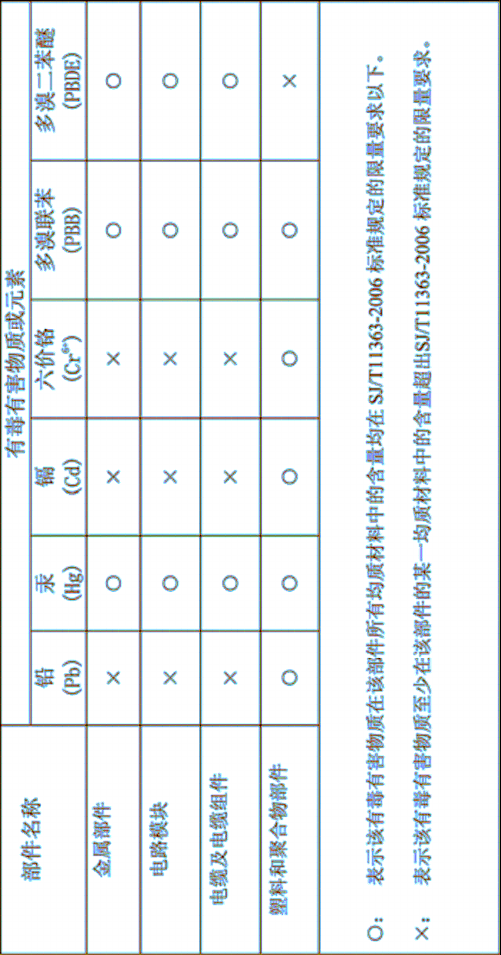
56
15.CMM Disclosure
The China Management Methods (CMM) Disclosure Table is intended only
to communicate compliance with China requirements; it is not intended to
communicate compliance with EU RoHS or any other environmental
requirements.
CMM Disclosure Information
57
16.Copyrights and Trademarks
N
N
No
o
ot
t
ti
i
ic
c
ce
e
e
While reasonable efforts have been made to assure the accuracy of
this document, Motorola, Inc. assumes no liability resulting from any
inaccuracies or omissions in this document, or from use of the information
obtained herein. The information in this document has been carefully
checked and is believed to be entirely reliable.
However, no responsibility is assumed for inaccuracies or omissions.
Motorola, Inc. reserves the right to make changes to any products
described herein and reserves the right to revise this document and to
make changes from time to time in content hereof with no obligation to
notify any person of revisions or changes.
Motorola, Inc. does not assume any liability arising out of the application or
use of any product, software, or circuit described herein; neither does it
convey license under its patent rights or the rights of others.
It is possible that this publication may contain references to, or information
about Motorola products (machines and programs), programming, or
services that are not announced in your country.
Such references or information must not be construed to mean that
Motorola intends to announce such Motorola products, programming, or
services in your country.
C
C
Co
o
op
p
py
y
yr
r
ri
i
ig
g
gh
h
ht
t
ts
s
s
This instruction manual, and the Motorola products described in this
instruction manual may be, include or describe copyrighted Motorola
material, such as computer programs stored in semiconductor memories
or other media. Laws in the United States and other countries preserve for
Motorola and its licensors certain exclusive rights for copyrighted material,
including the exclusive right to copy, reproduce in any form, distribute and
make derivative works of the copyrighted material. Accordingly, any
copyrighted material of Motorola and its licensors contained herein or in
the Motorola products described in this instruction manual may not be
copied, reproduced, distributed, merged or modified in any manner
without the express written permission of Motorola. Furthermore, the
purchase of Motorola products shall not be deemed to grant either
directly or by implication, estoppel, or otherwise, any license under the
copyrights, patents or patent applications of Motorola, as arises by
operation of law in the sale of a product.
58
U
U
Us
s
sa
a
ag
g
ge
e
e
a
a
an
n
nd
d
d
D
D
Di
i
is
s
sc
c
cl
l
lo
o
os
s
su
u
ur
r
re
e
e
R
R
Re
e
es
s
st
t
tr
r
ri
i
ic
c
ct
t
ti
i
io
o
on
n
ns
s
s
L
Li
ic
ce
en
ns
se
e
A
Ag
gr
re
ee
em
me
en
nt
ts
s
The software described in this document is the property of Motorola, Inc
and its licensors. It is furnished by express license agreement only and may
be used only in accordance with the terms of such an agreement.
C
Co
op
py
yr
ri
ig
gh
ht
te
ed
d
M
Ma
at
te
er
ri
ia
al
ls
s
Software and documentation are copyrighted materials. Making
unauthorized copies is prohibited by law. No part of the software or
documentation may be reproduced, transmitted, transcribed, stored in a
retrieval system, or translated into any language or computer language, in
any form or by any means, without prior written permission of Motorola, Inc.
H
Hi
ig
gh
h
R
Ri
is
sk
k
M
Ma
at
te
er
ri
ia
al
ls
s
Components, units, or third-party products used in the product described
herein are NOT fault-tolerant and are NOT designed, manufactured, or
intended for use as on-line control equipment in the following hazardous
environments requiring fail-safe controls: the operation of Nuclear Facilities,
Aircraft Navigation or Aircraft Communication Systems, Air Traffic Control,
Life Support, or Weapons Systems (High Risk Activities). Motorola and its
supplier(s) specifically disclaim any expressed or implied warranty of fitness
for such High Risk Activities.
Trademarks
MOTOROLA and the Stylized M Logo are registered in the US Patent &
Trademark Office. All other product or service names are the property of
their respective owners.
© Motorola, Inc., 2007
59